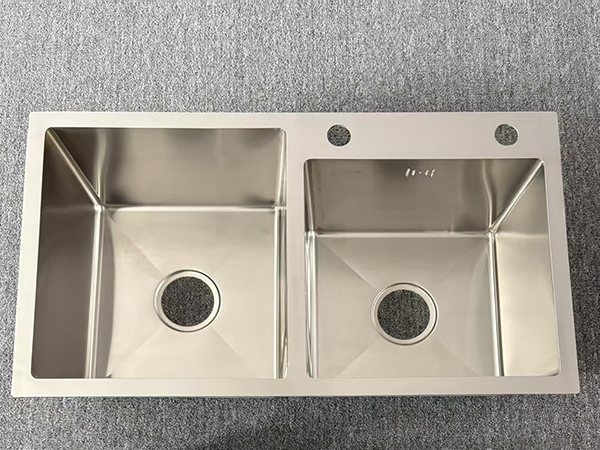
Double Bowl Sink
To ensure even gaps between the countertop and Double Bowl Sink during installation, the following methods can be used as a reference:
Preparation before installation
Accurate measurement: Use precise measuring tools such as tape measures, calipers, etc. to carefully measure the dimensions of the sink, including length, width, and depth. At the same time, measure the size of the table opening to ensure that they match and the error is controlled within a very small range. Generally speaking, the size of the opening on the countertop should be slightly smaller than the external dimensions of the sink, usually 1-2 millimeters smaller on each side, to ensure that the sink can fit tightly with the countertop after installation.
Check the sink and countertop: Before installation, carefully inspect the flatness of the sink and countertop. Place the sink on a horizontal surface and observe if there is any deformation or warping of the sink; For countertops, use a level to check if the surface is flat. If there are any uneven areas, they need to be polished or trimmed to ensure that the installation foundation is flat.
installation processing control
Positioning and Marking: Gently place the sink at the opening on the countertop, making it roughly centered. Then use a pencil or masking paper to mark the outline of the sink on the edge of the table opening as a positioning reference during installation. The markings should be clear and accurate for easy reference and inspection during installation.
Use auxiliary tools: Some auxiliary tools can be used to ensure even gaps. For example, place a thin gasket, such as a plastic gasket or rubber gasket, between the edge of the sink and the edge of the countertop opening. The thickness of the gasket should be uniform and consistent, usually 1-2 millimeters. These gaskets can serve as buffers and adjusters, keeping the gap between the sink and the countertop even. You can also use fixtures to fix the sink to the countertop. During the fixing process, adjust the position and strength of the fixture to evenly press the sink onto the countertop, ensuring even gaps.
Multi person collaboration: If conditions permit, it is best to have two or more people collaborate for installation. One person is responsible for smoothly placing the sink into the opening and adjusting the position of the sink according to the markings and auxiliary tools, while the other person observes the uniformity of the gaps nearby and promptly reminds adjustments to ensure that the sink remains level and the gaps are even during installation.
Check and adjust after installation
Preliminary inspection: After the installation of the sink is completed, the first step is to conduct a preliminary inspection. Observe the gap between the sink and the countertop from different angles to see if there are any obvious differences in width. If uneven gaps are found, promptly identify the cause and make adjustments. It may be that the sink position is not aligned properly, or that the gasket or fixture in a certain part is not adjusted properly.
Fine adjustment: For some less obvious uneven gaps, a feeler gauge can be used for precise measurement. Adjust the sink according to the measurement results. For example, if a gap is found to be wide in a certain area, the sink can be moved slightly in that direction or a shim can be added at the corresponding position; If the gap is narrow, you can slightly adjust the angle of the sink or reduce the thickness of the gasket.
Sealing treatment: After ensuring uniform gaps, perform sealing treatment. Apply high-quality glass glue or sealant evenly along the gap between the sink and the countertop. When applying, pay attention to the uniform thickness of the adhesive layer, generally controlled at around 2-3 millimeters. Excessive thickness of the adhesive layer may lead to adhesive overflow, affecting its appearance, while excessive thickness may affect the sealing effect. After application, use a tool to scrape the adhesive flat to form a smooth and uniform sealing layer.
How to choose a sink suitable for your kitchen?
Choosing a sink that suits your kitchen requires comprehensive consideration of multiple fa ...
2025-05-12
Possible issues that may arise during the use and installation of kitchen sinks
There may be various problems during the use and installation of kitchen sinks, and the fol ...
2025-05-12
How to choose a suitable stainless steel sink
A good stainless steel sink uses thicker plates,and the thickness can be determined by slig ...
2025-04-10
How to choose a kitchen sink
Stainless steel:It has the advantages of strong corrosion resistance,not easy to rust,easy ...
2025-04-10


